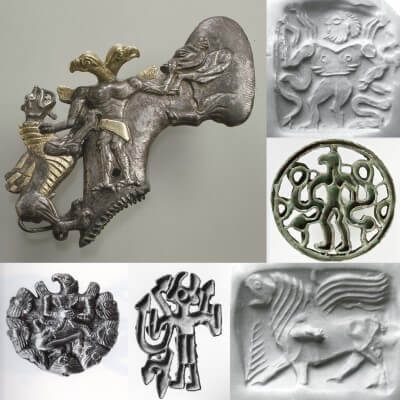Bactria Margiana Archaeological Complex

This culture existed from 2300 BC to 1700 BC in the territory of what is modern day Northern Afghanistan, Eastern Turkmenistan, Southern Uzbekistan and Western Tajikistan in the upper reaches of the Amu-daria river. BMAC held extensive trade contacts with ancient Elam and the Indus Valley (Harappan) Civilisztion.
The Oxus Civilization (BMAC) is different from other Indo-European cultures because at the end of its existence it could represent a mixtrue of indigenous people (Chalcolithic Central Asians) and Indo-European nomads from the Andronovo Culture, who together created a totally new Tazabagyab Culture in the terrtiory of BMAC. Later the kurgan (tumulus) burials associated with the Andronovo and Tazabagyab cultures were found in the territory of Northern Tajikistan.
Very interesting seems the image of a hero with a head of an eagle, who holds two serpents in his hands or two animals (master of animals motif). This could be an image of Garuda eagle, who hated Nagas (serpents) and hunted them down. This is a similar concept to a Norse Great Eagle from the top of Yggdrasil who hated a serpent-like Niðhöggr, who eats the roots of the World Tree.
This might also be a depiction of a Sumerian god Ninurta, who was often portrayed with a head of an eagle. His name would then maybe turn to the name of Indra (Indar, Intra, Inurta) among the Indo-Aryans. The influences of proto-Elamites were already evident in the 3500 BC Geoksyur site of Central Asia.
The BMAC was eventually overrun by the Indo-Iranian migrations from the Andronovo Culture and Sintashta Culture and became Indo-Europeanized. The Indo-Aryans pursued their Southward expansion, invading Northern Pakistan and Northwest India from 1800 BC to 1200 BC.
DNA
The sequencing of ancient Harappan genome revealed that the people of the Indus Valley Civilization were the primary ancestors of most living Indians (modern South Asians). It lacked the genetic input from European Steppe Pastoralists (WSH). That Yamna related genetic input appears only in post-1400 BC Gandhara Grave Culture samples from Swat Valley, Pakistan[1].
The Steppe ancestry in South Asia has the same profile as that in Bronze Age Eastern Europe, tracking a movement of people that affected both regions and that likely spread the distinctive features shared between Indo-Iranian and Balto-Slavic languages[2][3].
Much better coverage of the BMAC genetics can be found in the Y-DNA haplogroup R2 article.
First published on the 17th of October 2018. Article updated with genetic information from the Cell Journal on the 8th of Novemeber 2022. Some editoral changes were made on the 21st of December 2022, for example the demise of the Indus Valley Civilization is not associated with some 1300 BC invasion.
